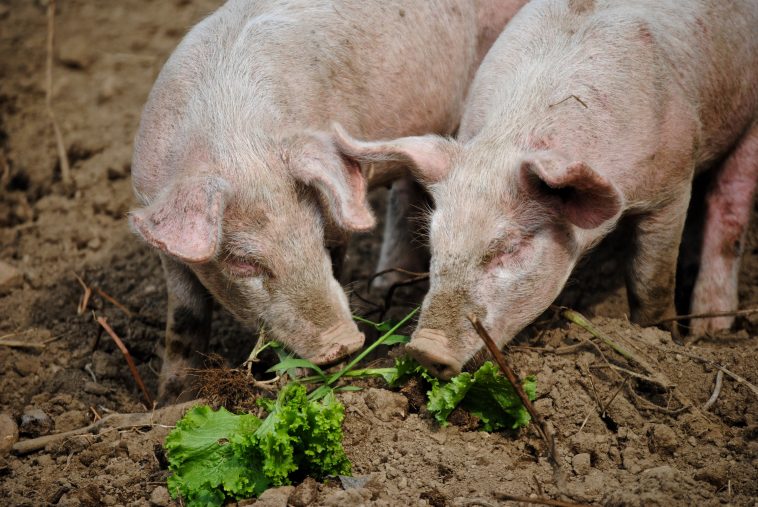An integral part of piggery is the feed the animals consume. The quality of the feed and feed uptake are closely related to parameters such as the Feed Conversion Ratio (FCR) of the animals, disease resistance, and reproduction. The optimum performance of the pigs regarding these three qualities determines the quality and eventually the price that will be placed on the product, and the income received.
The FCR is the quantity of feed consumed by an animal to be converted into one kilo of live weight. This parameter of conversion of high-quality feed is paramount in modern pig production, especially considering the ever-increasing feed costs. FCR is built into most feed and performance recording systems as an axiomatic and necessary parameter.
In a piggery, between 60 and 80% of the cost of production is directed to feed and usually around two to three kilogrammes of quality feed produces on average a kilogram of live weight gain. The lower this is or the closer to 2 kg the better the FCR is.
The health status of the pigs always affects the efficiency and effectiveness of the conversion process, thus farmers may find that some healthy pigs will convert at 1:1,8 (1 kg weight for 1,8 kg of feed), but some will return figures of 10, that is 1 kg of weight gain for 10 kg of feed input. This discrepancy in performance indicates the health status of the herd. Pigs needing 10 kg of feed for a 1 kg weight gain will be clinically sick pigs. FCRs of four or five can be attained from sub-clinically sick pigs.

Pigs crowding together to stay warm during feeding means that each pig has less room at the trough. (Image source: pexels.com Barbara Barbosa)
A myriad of factors affects the FCR in a piggery, chief among them being the environment, temperature, sickness, genetics, and quality of feed.
Environment and temperature
The ambient temperature of the pen should be maintained in the thermoneutral range from as low as 10 °C and up to 23,9 °C. Outside of this temperature range, pigs will want to eat either too much or too little.
Growers require temperatures of 20 °C to 23,9 °C, finisher’s need 10 °C to 15,6 °C and gestating sows need temperatures of 15,6 °C to 18,3 °C.
Cold pigs generally eat more due to the need to convert the feed into heat and hot pigs will eat less to keep their body temperatures lower. Other factors associated with a badly maintained environment are poor regulation of humidity and ventilation. High humidity will reduce a pig’s appetite as does poor ventilation.
The stocking rate is also determined by the ambient temperature outside of a pig’s normal temperature range. A reduced area per animal intensifies stress and results in decreased feed intake. During feeding, pigs crowding together to stay warm means less space per pig at the trough, thus less consumption.

Ambient temperature affects the stocking rate. (Image source: pexels.com by Mark Stebnicki)
Sickness
Generally, sick pigs do not eat much, or they may overeat without much positive weight gain. This is why it is important to implement disease prevention strategies from project inception to closing to protect your animals and maintain a healthy herd.
A period of sickness can lead to loss in appetite and low weight gain. Cutting down consumption automatically translates to poor growth of animals.
Regulating the microflora in the pig gut promotes nutrient absorption. Feed additives containing probiotic micro-organisms or organic acids can be periodically substituted for antibiotics to help lower the FCR.

Sows require a balanced diet to ensure the health and vitality of their offspring. (Image source: pexels.com)
Genetics
As piggery production systems are required to be optimally financially viable, is it crucial that the breed utilised for the production system is the best. About 30% of a herd’s success is dependent upon the genetic potential of the pigs.
Breeding techniques that optimise growth rates and improved FCRs can be achieved through proper crossbreeding. Many genetics companies rely on the Osborne FIRE Performance Testing Feeders to quantify daily feed intake and growth characteristics to help improve genetic selection.
The Osborne’s FIRE (Feed Intake Recording Equipment) System automates the measurement of individual animal’s daily feed intake and other pig performance characteristics of growing animals. FIRE is the acknowledged standard for pig performance testing at commercial facilities and universities worldwide: it is currently used by more genetics companies than any other system.
Quality of feed
Malnutrition or minerals and vitamin deficiencies of livestock weaken the pigs’ immune systems, thereby subjecting them to the effects of a multitude of illnesses. These deficiencies and malnutrition usually stunt pigs’ growth, development, and production and in some cases may result in irreversible health conditions, ailments, or avoidable mortalities.
A lack of certain minerals such as calcium, zinc, magnesium, selenium, and manganese can reduce fertility and can disrupt the balance of gestation and parturition hormones. Also, improper nutrition may lead to poor foetal development, stunted growth after birth, and high pig mortality rates in severe cases.
The reproductive vitality of male animals is affected by pig nutrition. Pigs reared for reproduction purposes need balanced diets to ensure their offspring’s health and viability.









